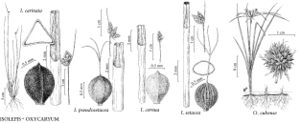Isolepis cernua
in J. J. Roemer et al., Syst. Veg. 2: 106. 1817.
Plants annual (or perennial?); rhizomes usually obscured by culm bases and very short, sometimes vertical and elongated. Culms 4–40 cm × 0.2–0.5 mm. Leaves sometimes sparsely orange-punctate at 10–15X; sheaths usually reddish proximally; distal blade rudimentary to much longer than sheath, often exceeding culm, to 20 cm × 0.2–1 mm. Inflorescences: involucral-bract 1, sometimes subtending flower or resembling enlarged floral scale, 2–6 (–23) mm. Spikelets 2–5 × 1–2 mm; scales partly or completely dark orange to redbrown, rarely stramineous, midrib greenish to stramineous, not gibbous, obscurely to prominently 3–11-veined, midrib keeled near apex, membranous, hyaline, apex rounded to acute, with mucro less than 0.1 mm; proximal scale to 2 mm; other scales 1.2–1.8 × 1–1.3 mm. Flowers: anthers 0.3–0.6 mm; styles 3-fid or 3-fid and 2-fid. Achenes falling separately from scales, medium to dark-brown or stramineous, ellipsoid to obovoid, compressedtrigonous to thickly biconvex, lateral angles usually prominent, abaxial angle prominent to obscure, faces convex or adaxial face slightly concave, 0.8–1 × 0.5–0.7 mm, distinctly papillose at 10–15X to obscurely papillose at 40X, often with thin whitish surface layer. 2n = 30.
Phenology: Fruiting late spring–winter (Pacific Coast), winter–spring (Texas).
Habitat: Wet, freshwater to brackish places on beaches, dunes, marine bluffs, sandy areas, mostly coastal
Elevation: 0–800 m
Distribution

B.C., Calif., Oreg., Tex., Wash., Mexico (Baja California), temperate South America, Eurasia, Africa, Australia, New Zealand
Discussion
Isolepis cernua is widespread and variable. Four varieties were recognized by A. M. Muasya and D. M. Simpson (2002). Only var. ceruna is known from North America. The earliest collection I have seen from the Pacific Coast is from 1888; the earliest collection I have seen from Texas is from 1974.
Selected References
None.
Lower Taxa
"shortened" is not a number."elongated" is not a number.
